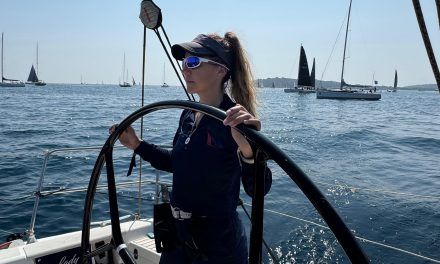Pablo Berruezo, born 28 years ago in a Catalan family of seafaring tradition, is a naval engineer, and has decided to undertake the great challenge of sailing around the world in a sailboat and alone.
After several months preparing his sailboat, Pablo is ready to start this great adventure and try to fulfill a dream he has had for many years.
We thank Pablo for sharing with us in this interview, his project, how has been the preparation, and the main challenges that lie ahead.
Interview with Pablo Berruezo
Pablo, how were your beginnings in sailing?, what experience have you accumulated before starting this project?
I started sailing at a very young age, before studying at the Nautical Faculty of Barcelona. Since then I have had the opportunity to sail different seas, accumulating thousands of miles and experience, working as a crew member on sailboats.
In addition to my academic training, since I was a child my family has also instilled in me a passion for the sea and sailing, sailing from a very young age in the bay of the Ebro Delta.
What drives you to undertake this round-the-world sailing project?
What drives me to carry out this project is to be able to fulfill a dream I have always had.
Being aware that time passes in the blink of an eye has made me start this project and set a start date for it.
In the following video (in spanish language) Pablo tells in his YouTube channel how his oceanic project arises:
How is the boat? What technical qualities should a boat have to sail around the world solo?
The boat is a sailboat of 12 meters in length from 2007, a good length to handle it alone. The main quality that a boat must have is self-sufficiency, that is, being able to produce drinking water, more energy than you consume and to be able to store enough provisions.
Obviously the rig and sails are very important.
How has the preparation turned out?.
What is the most complicated part of getting a sailboat ready for this great adventure?
The preparation has been intense and required attention to every detail.
The most challenging has been coordinating the installation of the electrical system on board, making sure it can be self-sufficient in power, and making sure the safety systems are ready for the extreme conditions I may encounter. Coordinating the materials and some of the work has been a real challenge.
Fortunately, I have had the help of Tallers Cornet de la Ràpita who have fully taken care of the engine and other boat parts such as the diesel fuel tank, among others.
Can you tell our readers how you have planned your trip?
What route will you follow and the approximate dates?
The route I will follow will start in the Mediterranean, passing through the Panama Canal, then across the Pacific to French Polynesia and on to the Torres Strait. I will then sail to Bali, the Indian Ocean, South Africa, and back across the Atlantic, making stops at islands such as St. Helena and Ascension.
I plan to leave in mid-October and complete the trip in about a year and a half, depending on weather conditions.
In the following video Pablo tells on his YouTube channel how he has planned his route:
Weather is a key factor in ocean sailing.
How have you organized yourself to have sufficient information at sea?
Meteorology is essential in this type of voyage.
I will have the support of Predict Wind, who are sponsors of my project and give me access to their premium services. This will allow me to receive real-time weather updates and adjust my navigation according to the conditions.
Onboard electrical power management is also very important,
How have you designed the ship’s electrical system?
My electrical system is designed to be self-sufficient during the crossing. I have four 150 Ah batteries in parallel, two solar panels of 380W each, and, thanks to Disvent, I have a 420W wind generator and a Phoenix 12/2000 inverter, which allows me to use alternating current for critical systems.
All this is integrated with independent solar regulators for each panel, which ensures efficient energy management.
Finally, Pablo, what do you consider to be the most difficult challenges you will face during the round-the-world trip?
Solo sailing requires great mental fortitude, as well as being prepared for any technical eventuality that may arise on the high seas. One of the difficult challenges is sleep management, as 24-hour solo sailing makes it difficult to rest.
Another challenge is the weather conditions, which can be very adverse, and learning to manage the boat and your nerves in these conditions can be very difficult.
Added to all this are the logistical challenges in terms of provisions (such as fuel and food).
You can follow Pablo Berruezo in his round-the-world sailing adventure in the following channels:
From “Navegantes Oceánicos” (Bluewater Sailors) we thank Pablo for his collaboration with this interesting interview and we wish him fear winds and following seas, and good luck in this great adventure around the world solo sailing.
Quite an oceanic challenge!











